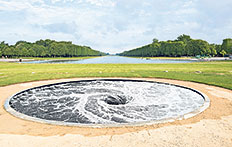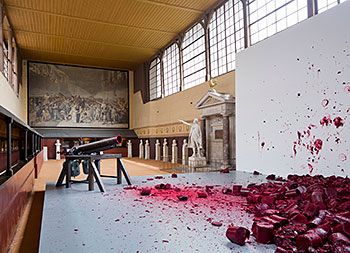Palace revolutionary: Anish Kapoor at Versailles
Simply sign up to the Life & Arts myFT Digest -- delivered directly to your inbox.
He pulls the clouds down from the sky, upturns the earth, bends the straight façade of the château into a curvaceous mass, and places a noisy dark whirlpool between tinkling gilded fountains. With just five sculptures in 800 hectares of grounds, Anish Kapoor subverts an emblem of orderly splendour and national pride with monumental metaphors of instability, violence and the chaos of nature.
Anish Kapoor Versailles plays on the relationship between spectacle and history. For in landscape architect André Le Nôtre’s grand 17th-century formal gardens, Kapoor has met an imagination as inventive and uncompromising as his own, and the dialogue between the two artists turns Versailles this summer into a metaphysical playground.
The show opens with one of Kapoor’s most popular works, the highly polished reflective steel wall “C-Curve”, which circles back on itself like the letter C. Wittily installed beneath the château’s 73-metre Hall of Mirrors, it stands at a central point of Le Nôtre’s linear geometric design to look down on the vista of manicured lawns, broad parterres, ornamental lakes and exquisite rows of boxed hedges. Its convex side distorts and defamiliarises in reflection the château, which appears as a bulging, rounded form; its concave side turns everything, including our own mirrored selves, upside-down.
Created in 2007, “C-Curve” has delighted audiences in installations from Kensington Gardens to England’s South Downs, and this week, even before the show officially opened, crowds bearing selfie-sticks were jostling to get near it. But in Versailles the democratic allusion is amplified. Louis XIV inaugurated the gardens in 1664 with a week-long fête galante for the aristocratic elite called “Les Plaisirs de L’Île Enchantée”. Now Kapoor makes all of us the enchanted visitors, brief players flitting across his glassy pageant — which is also a contemporary drama of multiplicity and inversion, reality and illusion, individual and collective identity.

An unfolding pleasure here is the contrast between Le Nôtre’s strict lines and static chequerboard patterns, embodying ancien régime equilibrium, and Kapoor’s curving, looping aesthetic, full of movement and dynamism. A second reflective steel piece, the spherical “Sky Mirror”, works as a constantly mutating cloudscape painting, changing from dawn to dusk with shafts of sun on occasion so bright that its dazzling surface seems set alight. And so there is an unlikely resonance here with Versailles’ focal “Apollo Fountain”, which depicts the Greek sun god driving his chariot and horses to light the sky — Le Nôtre’s analogy for the divinely commanded power of the Sun King Louis XIV.
Versailles tells the story of kings; Kapoor says “Dirty Corner”, the show’s most provocative sculpture, is suggestive of “a queen reclaiming the domain”. At 60 metres long, “Dirty Corner” is a Cor-Ten steel tube with a weathered patina like bronze; it begins with a nine metre-high goblet-shaped entrance, and gets narrower and narrower, darker and darker, tapering to a closed tunnel. Flamboyantly sexual in its vulva-like imagery, the sculpture represents nature’s challenge: an erotic, feminised disruption to Le Nôtre’s masculine rigidities and tamed harmonies of lawn and hedge.
Engagement with a cultural setting is a determining factor for a large-scale Kapoor work. “Dirty Corner” was first shown in 2011 in a former tram factory in Milan, where it looked claustrophobic and urban. Here, rising on the Tapis Vert, a grass rectangle between fountains and bosquets, “Dirty Corner” is surrounded by pink-veined boulders each weighing 10 tonnes, and covered in places by heaps of soil. Stones, earth and excavated ground around the sculpture are painted in parts a powdery deep red, and carved with gashes like giant wounds. It feels like the aftermath of an earthquake. Nearby, the ground actually does shake in response to an accompanying piece, the whirlpool “Descension”, a pool of dark water sucked by a vibrating motor into a black vortex.
With echoes of some of Kapoor’s most potent sculptures — from his 1970s pigment-powder pyramids to “Marsyas” (2002), the giant trumpet shown at Tate Modern — “Dirty Corner” and “Descension” marvellously distil the contrasts that have always animated Kapoor’s work: solid and void, interior and exterior, light and dark, visible and invisible, rough and smooth, the relationship between physical and psychological.
It is a triumph, too, of the exhibition’s itinerary that it progresses from the open, mirrored pieces referencing landscape to more difficult formal sculptures turning on the elemental — earth and water — and from those that reflect and utilise the order of the garden to those that react against it.
Reached via a labyrinth of paths through darkening groves, the last work in the grounds is “Sectional Body Preparing for Monadic Singularity”, a red cube built from interlaced fabric tubes. You can enter and clamber over this body as landscape or landscape as body, which lets in light and circles of sky at surprising angles within its labyrinth of arteries and veins.

But a show at Versailles cannot end on a note of interiority. Unlike other artists recently invited here (Jeff Koons, Takashi Murakami), who installed gaudy horrors in the Hall of Mirrors, Kapoor declined to place work inside the palace. Typical of his more historically sensitive approach is a decision to inaugurate use of Versailles’ Salle du Jeu de Paume, the indoor tennis court where, on June 20 1789, representatives met to forge the constitution marking the birth of modern France.
Lined with marble busts and a statue of early revolutionary hero Jean-Sylvain Bailly swearing the Tennis Court Oath, the panelled room with light streaming through tall windows is quiet and little-visited today. Kapoor reanimates it: he has installed “Shooting into the Corner”, the wax-firing cannon first shown in 2009 at London’s Royal Academy, with crimson cartridges and messy blots and splodges of wax, evocative of flesh and entrails, here already piled high like bloodied corpses, while the cannon is positioned in visual parallel to Bailly’s optimistic but doomed outstretched arm (Bailly was guillotined in 1793).
With each intervention here, Kapoor unravels meanings accumulated during the course of history. In the palace gardens, he disturbs the territory disciplined by Le Nôtre with a vocabulary at once his own and inflected by subjects that preoccupied the creators of Versailles: the energy of flowing water, the power of the sun, the reflections of mirrors. At the Salle du Jeu de Paume, he goes further, confronting a theme unavoidable in Versailles: oppression and the conquest of freedom. The result is a terrific show: visually stunning, intellectually engaging, and a moving meditation on nature and civilisation.
‘Anish Kapoor Versailles’, June 9-November 1, en.chateauversailles.fr
Photographs: Tadzio; Fabrice Seixas
Comments